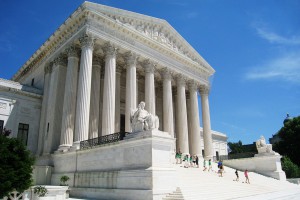Supreme Court of the United States of America: The Full Court of John J. Roberts, CJ. and Samuel A. Alito, Stephen G. Breyer, Brett Michael Kavanaugh, Elena Kagan, Clarence Thomas, Neil McGill Gorsuch, Ruth Bader Ginsburg, Sonia Maria Sotomayor, JJ. upheld the constitutionality of Bladensburg Cross holding that the memorial was not an endorsement of Christianity.
The present case pertained to the constitutionality of a memorial built on public land in Maryland to honor fallen soldiers in World War-I, which was in the form of a 40-foot cross known as Blandensberg Peace Cross. In 2014, the American Humanist Association (AHA) lodged a complaint in District Court of Maryland alleging that the Cross’ presence on public land and maintenance of the memorial violated the Establishment Clause of the First Amendment to the US Constitution which stated that “Congress shall make no law respecting an establishment of religion”. AHA sought declaratory and injunctive relief claiming removal or demolition of the Cross, or removal of the arms from the Cross so that it forms non-religious slab. The American Legion intervened to defend the Cross and pleaded that the Cross’s history, setting, and secular elements did not impermissibly endorse religion.
The District Court held that the existence of Cross satisfied the Lemon Test[1]. Applying the test the Court determined that the Commission had the secular purpose of acquiring and maintaining the Cross, to commemorate World War I and to ensure traffic safety and concluded that the Cross was constitutional. However, the Court of Appeals for the Fourth Circuit reversed the said judgment opining that although the monument had several secular elements they were overshadowed by the Cross’ size and its Christian connection. It was held that the Cross failed Lemon’s Test as Commission excessively got entangled with religion by spending excessive public funds to maintain it; and a reasonable observer would view the Commission’s ownership and maintenance of the monument as an endorsement of Christianity. Thus, the present appeal.
The Supreme Court, by a majority of 7:2 held that the meaning of the Cross was not limited only to its historical context and that the 94-year-old cross was a ‘historical landmark’ destruction of which would be disrespectful. It was opined that though the Cross was “undoubtedly a Christian symbol”, but the monument had come to represent “a symbolic resting place for ancestors who never returned home, a place for the community to gather and honour all veterans and their sacrifices for this Nation, and a historical landmark”.
It was observed that even if the original purpose of a monument be infused with religion, passage of time may obscure that sentiment; and as the society becomes more and more religiously diverse, a community may preserve such monuments, symbols, and practices for the sake of their historical significance or their place in a common cultural heritage. The Court gave the example of the Notre Dame Cathedral in Paris and observed that “with sufficient time, religiously expressive monuments, symbols, and practices can become embedded features of a community’s landscape and identity.”
In view of the above, it was held that destroying the Bladensburg Cross “would not be neutral and would not further the ideals of respect and tolerance embodied in the First Amendment”.[American Legion v. American Humanist Association, 588 US 2019, decided on 20-06-2019]
[1] Lemon test was enunciated in the case of Alton J. Lemon v. David H. Kurtzman. Under the said test, while determining if a particular law violates the 1st Amendment of the US Constitution, a Court must-see if: (i) the statute has a secular purpose; (ii) the ‘principal or primary effect’ of the statute must be one that ‘neither advances nor inhibits religion’; and (iii) the statute does not foster ‘excessive government entanglement with religion’.

